Menu
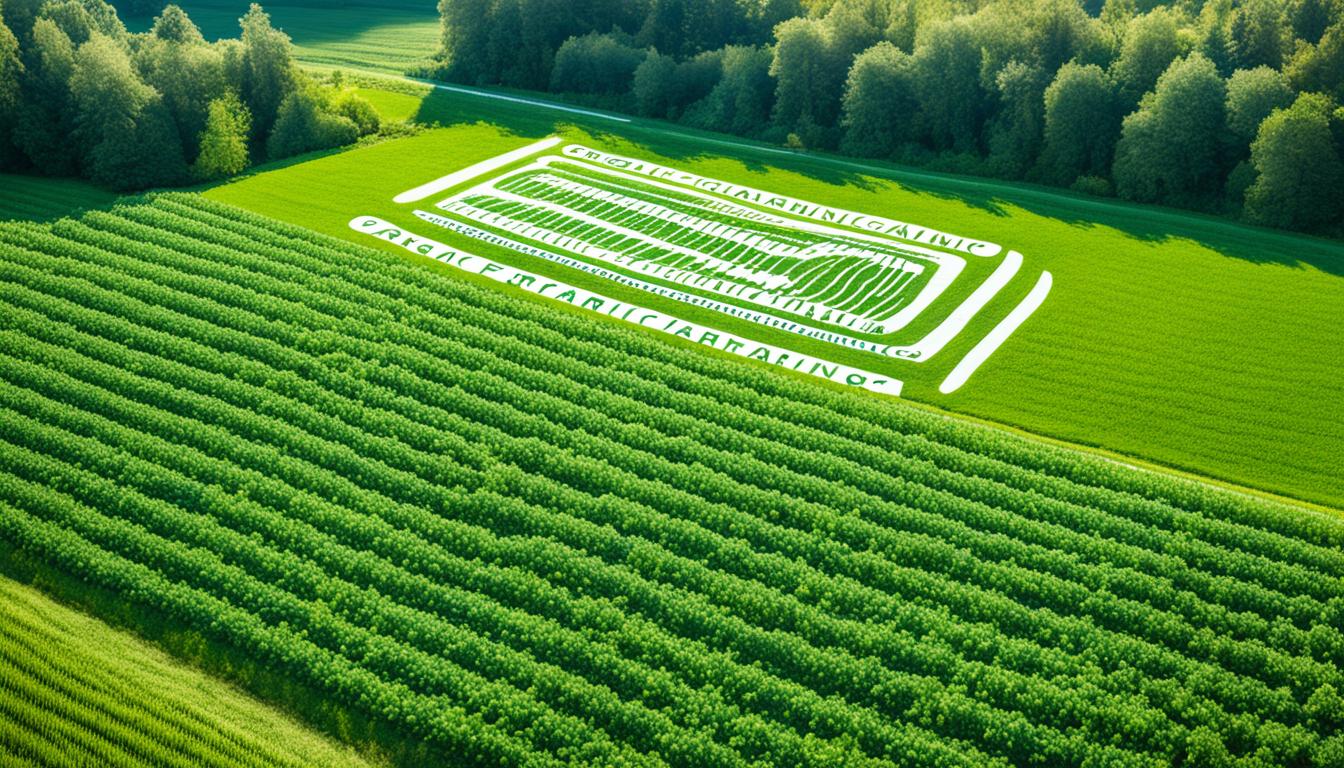
Did you know small farmers, earning less than $5,000 from organic sales, are not required to be certified? The organic farming industry has grown a lot since its start in the 1940s. It began with small experiments and now features big farms. These farms use special organic labels to sell their produce.
With this growth came the need for clear checks to make sure products were really organic. Today, more than 40 groups and agencies check and label organic food in the USA. But, they all have their own rules. So, the Organic Foods Production Act of 1990 was set up to make one set of rules for everyone. This led to the creation of the National Organic Program (NOP) under the USDA. Its job is to make sure organic standards are the same everywhere. This gives consumers trust in what they’re buying. I’m looking into how following both organic and environmental rules can help make farming more sustainable.
Organic farming is all about following specific rules to help nature. It means not using man-made fertilisers and bug-killing chemicals on plants. Instead, farmers can use bug killers from nature. They can’t use genetic meddling, make clones, use fake drugs, or other stuff that’s not pure.
The National Organic Program (NOP) is very clear about what organic means. Products need to be at least 95% made of organic stuff to show the Canada Organic Logo. Farmers must keep the soil rich without chemicals and find natural ways to deal with bugs. When products are sent to other countries, they must meet their organic rules too.
Rules for the environment help farming last a long time. They make sure farms don’t hurt the planet. The Canada Organic Trade Association says organic farming is a big help in taking care of nature. They don’t use fake stuff and protect different plant and animal types. In the U.S., farms that want to be known as ‘organic’ have to follow strict plans and get checked often. This shows that farming the right way matters a lot, both for nature and for people who buy organic items.
| Organic Farming Standards | Environmental Benefits |
|---|---|
| Non-synthetic materials use | Conserves biodiversity |
| Prohibition of sewage sludge | Prevents soil contamination |
| Certification compliance | Maintains ecological balance |
| International equivalency agreements | Ensures global standards alignment |
The tale of organic farming evolution in the United States dates to the late 1940s. It all began with small experimental gardens. Since then, it grew into a significant industry, fuelled largely by consumer worries and increased demand for safer food. A key moment in this growth was the passing of the Organic Foods Production Act (OFPA) in 1990.
The OFPA set the stage for clear and coordinated rules. This was needed to fix the confusion caused by many different standards. The National Organic Program (NOP) under the United States Department of Agriculture (USDA) was created. Its job was to make sure everyone followed the same organic farming and marketing rules.
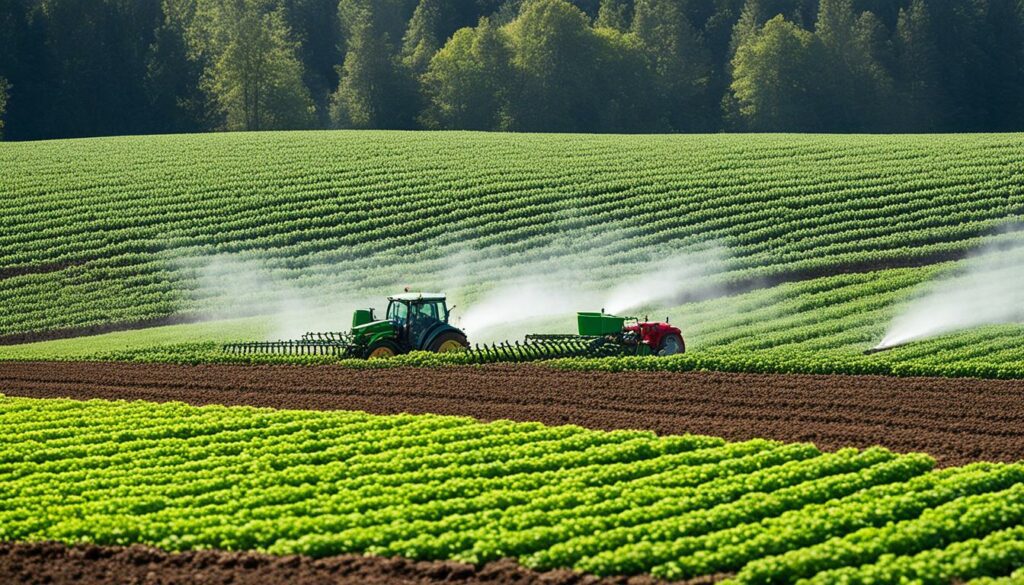
The NOP was vital for maintaining consistent marketing standards for organically produced agricultural products. This made certified organic products trustworthy to consumers everywhere.
Looking globally, in 2018, the world’s organic market hit over 100 billion U.S. dollars. The United States played a big role in this, pointing to a growing global interest in organic farming. There are now over 2.8 million organic farmers worldwide, working on 71.5 million hectares of land.
From 1999 to 2014, the area of organic farmland grew from 11 million hectares to 43.7 million. This shows significant progress worldwide and in the United States. These changes came with consumer choices, new laws ensuring food safety, and a more reliable organic market.
Lastly, let’s think about the money side of organic farming evolution. Organic products often cost more than non-organic ones, sometimes over 20% more from 2004 to 2010. But people kept buying them, showing their belief in the value of organic food.
The National Organic Program (NOP) is key in setting up organic farming rules in the US. It falls under the US Department of Agriculture (USDA). It makes sure organic rules are the same everywhere, building trust in organic labels for farmers and buyers.
NOP standards are made with great care. For crops to be organic, the land they grow on can’t have certain stuff for three years. This rule keeps the soil and crops truly organic.
The USDA made four types of organic labels based on how much of a product is organic. This makes it clear for people looking for organic stuff. It also means the products meet high NOP standards.
The NOP gets help from the National Organic Standards Board (NOSB) to pick what’s okay for organic farming. The board has people from various fields. They decide on using some man-made things, like bug-killing pheromones, only if they’re safe for people and nature.
Keeping up with NOP rules is very important for organic farming’s image. Certifiers have to check 5% of the organic farms every year for any harmful stuff. If these checks find too much bad stuff, that crop can’t be sold as organic.
The NOP also deals with other countries to trade organic goods. These trade deals make sure all organic food and products meet the same strict rules.
If someone thinks a farm isn’t following the NOP rules, they can report it. The NOP then looks into it. This keeps all organic farms on track with the rules.
| Aspect | Details |
|---|---|
| Crop Standards | Land free of prohibited substances for three years before harvest |
| Annual Residue Testing | At least 5% of certified operations sampled annually |
| EPA Tolerance for Pesticides | Residues must not exceed 5% of EPA tolerance |
| Organic Labels | Four categories based on organic content percentage |
| Trade Agreements | Specific requirements for importing/exporting organic products |
| Complaint Handling | Thorough investigation of alleged non-compliance |
The NOP works hard to make sure organic products are as they claim to be. By doing this, it helps people trust in the organic industry.
Using eco-friendly farming methods is key for long-term success. It focuses on cutting down the carbon footprint, looking after the soil, and saving the planet’s variety of life. These methods help make our world better and keep everything in balance.

Keeping a wide range of plants and animals is very important in eco-farming. Farms should be places where all sorts of living things can do well. This is essential for farmers to work in a balanced way with nature.
For a farm to be officially organic, it can’t use certain chemicals for three years on the land. This is before growing things that they plan to sell as organic. Also, they need to clearly mark their land to stop outside chemicals coming in.
Looking after the ground helps farmers keep going for the long run. They do things like changing the crops they grow every year. They also use special plants and animal-based stuff to make the soil better. This means the farm traps more carbon from the air and the soil gets stronger.
Greenhouses also have special rules to follow for their soil. These rules keep the soil safe for growing food. Using certain natural fertilizers is not allowed to make sure the food is healthy.
Farming the right way takes planning. Farmers rotate the types of crops they grow to protect the soil. They make sure to use special seeds and plants. Sometimes, they can use other ones if they can’t get the organic kind.
To deal with pests and keep weeds at bay, organic farmers have special ways. They change where they grow things and keep it clean. They use things like bugs or special tools, not harsh chemicals. This keeps the farm’s whole environment healthy.
In Europe, there are special plans to help farmers work in eco-friendly ways. These plans give farmers money to protect the environment and follow good farming rules. They help farm in a way that’s kind to the Earth.
Combining organic standards with environmental policies is key to healthy farming. When organic rules differ, it makes trading hard. It stops organic products from reaching more people. Challenges can include different ways of certifying and agreeing on what organic means.
Farmers and small businesses find it tough to meet many different standards. This can cost a lot of money and time. It’s important to work together to set rules everyone agrees on.
In the U.S., the Department of Agriculture is working on the Strengthening Organic Enforcement (SOE) rule. This rule helps track organic products better, fights fraud, and keeps the whole supply chain open. Making rules the same improves trust in organic food.
Getting everyone to agree on the same organic rules can change farming for the better everywhere. It makes it easier for farmers to follow the rules and for shoppers to trust what they’re buying.
Here’s a table that shows the effects of making organic rules the same for everyone:
| Factors | Impact |
|---|---|
| Compliance Costs | High for small-scale farmers |
| Trade and Market Access | Improved with standardised guidelines |
| Certification Barriers | Reduced through harmonisation |
| Consumer Confidence | Enhanced with unified standards |
Linking eco rules with organic farming helps balance nature, recycle resources, and support life. Making global organic standards the same can make getting certified easier, reduce paperwork, and create a more stable market for organic goods.
Sustainable agriculture helps tackle the environmental problems caused by modern farming. By 2050, the global population will grow to almost ten billion. We need farming methods that can meet this demand while keeping our planet safe.
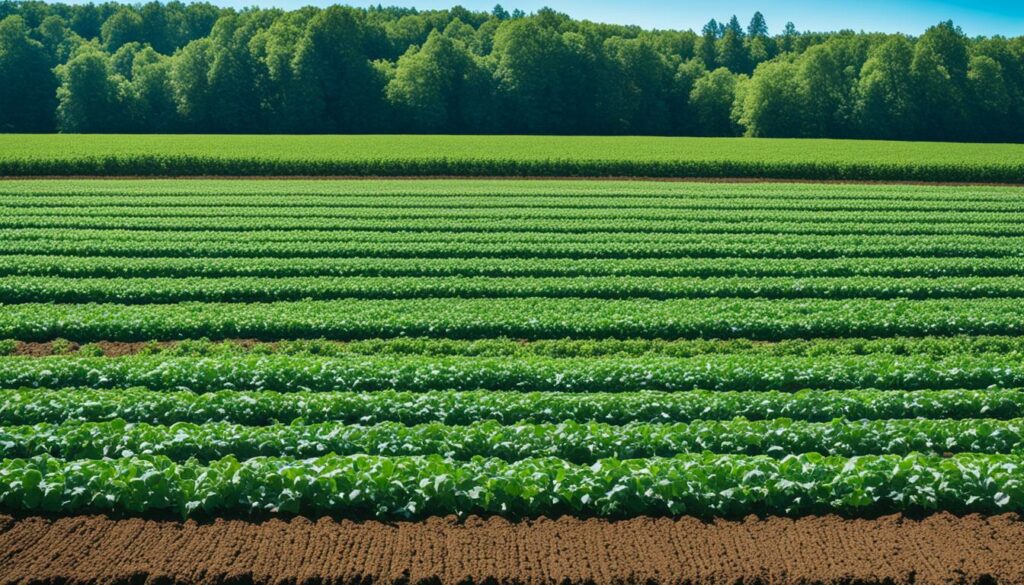
One main goal in sustainable agriculture is to lower its carbon footprint. The old ways of farming release lots of greenhouse gases. They use chemical fertilisers and pesticides. But, sustainable methods like organic farming don’t use these. This helps cut down on harmful gas emissions.
Changing to greener ways is good for our planet. It helps fight climate change.
By 2050, food production needs to increase by 70% to meet the growing population’s demands, and sustainable agriculture practices can help achieve this while minimising environmental impact.
Sustainable agriculture also makes the soil healthier. Methods like rotating crops and using organic compost are used. These practices make the soil richer and stronger. They help the land produce more. They also trap carbon in the soil, lowering the carbon footprint.
Keeping the soil healthy is key for long-term farming. It makes sure we can keep growing food sustainably.
| Benefit | Description |
|---|---|
| Carbon Footprint Reduction | Reduction in greenhouse gas emissions by avoiding chemical fertilisers and pesticides. |
| Soil Fertility | Improvement in soil health and structure through organic methods such as composting and crop rotation. |
| Environmental Impact | Minimisation of detrimental environmental impacts, fostering a more resilient ecosystem. |
| Social Equity | Ensures equitable access to nutritious food and creates economic opportunities for small-scale farmers. |
Practicing sustainable agriculture is crucial for our food system. It helps us meet growing food needs without hurting the environment. By lowering the carbon footprint and making soil healthier, we aim for a better, fairer future.
These methods keep our natural resources safe. They also help create jobs and make sure everyone can access healthy food.
Integrating organic standards with regular farming faces many challenges. One main issue is dealing with the lower yields of organically grown crops. There’s a big demand for organic food but its growth in the U.S. is slow. By 2008, less than 1% of crop land was used for organics, unlike Switzerland (11%) and Italy (9%).
Organic standards are tough to follow because they vary a lot. There are over 40 groups that certify food as organic. Trying to keep all their rules the same is hard. Organic farmers worry about their crops being affected by others which are genetically changed.
The organic livestock side is doing well. The number of cows and hens getting organic certification have increased a lot. But, to grow large, organic farms face challenges in keeping their products purely organic.
Using only natural methods to fight pests and disease is hard. Organic rules don’t allow many chemicals. This makes it hard to keep the soil healthy and stop weeds from hurting the crops.
Make no mistake, organic farming is risky and costly. While it can earn more than regular farming, there are extra costs. These include getting certified, keeping detailed records, and having the right tools and buildings. Small organic farms do not have to compete with big far away farms, but they struggle to grow due to not having enough resources.
Most organic farmers are older and have been farming for a long time. For organic farming to continue, we need to help younger people get into it. This might mean forgiving student loans for those who want to farm organically or giving them tax breaks to help them start.
But there is hope. To make it easier to farm organically, we need to fix the rules and offer more support. This includes keeping the National Organic Certification Cost-Share program going, doing regular surveys to update our knowledge, and funding research on organic farming.
| Aspect | Challenges | Proposed Solutions |
|---|---|---|
| Yield | Lower yields amid higher demand | Increase research funding for yield improvement |
| Compliance | Diverse certification standards | Regular organic production and certifier surveys |
| Scalability | Integrity of large-scale operations | Enhance cost-share programs and technical assistance |
| Pest Management | Restricted substances for pest control | Develop organic pest control methods |
| Demographics | Aging farming population | Support for young and beginning farmers |
Getting a natural farming certification is vital. It means your farming meets strict organic standards. The USDA Certified Organic label is a trusted badge of quality around the world.
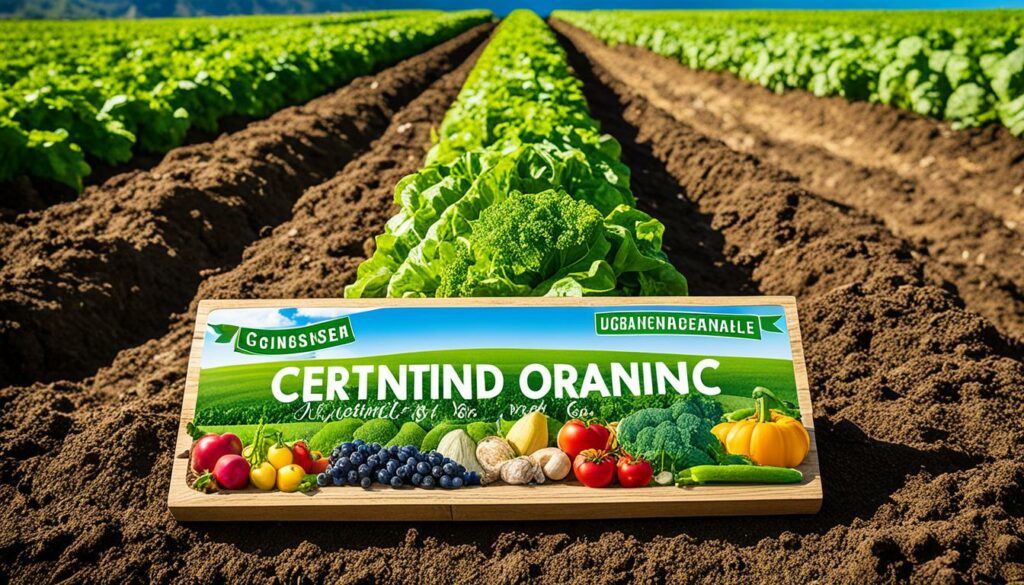
The USDA Certified Organic label shows a farm follows strict rules. For three years, they can’t use banned items on their land. Organic methods like crop rotation keep the soil healthy. This label checks that farmers do everything the right way.
Each year, official USDA inspectors check organic farms. They may show up without warning to really make sure things are organic. Studies show organic farming keeps crops, soil, and water safe from harmful stuff.
Besides the USDA Certified Organic label, the EU and India also have high organic standards. They make sure organic food is good for the earth and us. This makes organic farming strong all over the world.
By 2025, the organic market could hit $320 billion worldwide. As more people trust organic labels, these certifications become very important. People are ready to pay extra for organic, making these certifications more valuable.
For farmers switching to organic, there’s help. Programs like EQIP and the Organic Certification Program offer support. This makes it easier for farmers to meet organic standards and get certified.
To sum up, certifications like the USDA Certified Organic label do a lot. They show food is organic and grown in a safe way. With more people wanting organic food, these certifications help farmers and customers choose the best.
Here’s a quick look at key organic certification standards around the world:
| Certification | Region | Key Requirements |
|---|---|---|
| USDA Certified Organic | United States | No prohibited substances for three years, annual inspections, soil health maintenance |
| EU Organic Certification | Europe | Prohibition of synthetic inputs, maintaining biodiversity, strict labeling rules |
| NPOP | India | Certification of production, processing, and export, compliance with set standards |
Green agricultural policies are making a big impact. They push farmers to adopt more eco-friendly methods. These policies offer a lot of support. For example, during 2014-2020, the EU devoted €104bn, a quarter of its Common Agricultural Policy (CAP) budget, to fight climate change.
From 1990 to 2017, emissions from farming dropped by 21%. Yet, food production levels stayed the same. This shows the power of organic farming policy impact. It focuses on using fewer harmful chemicals. CAp 2023-27 aims to cut greenhouse gases to zero by 2050.
Science plays a big role in shaping these policies. Projects like iMAP give essential insights into farming’s environmental effects. Even though farming is a major emitter, it’s not well represented in the reduction efforts.
To gauge policy success, we use detailed monitoring maps and 28 environmental indicators. This helps keep track of how well these policies work. It ensures they achieve real benefits.
The success of organic farming policy impact can be seen in specific goals. Like the plan to start healing Europe’s biodiversity by 2030. The CAP’s new approach in 2023-27 includes tougher green rules. It connects organic practices with wider environmental aims.
| Aspect | Details |
|---|---|
| CAP Funding 2014-20 | €104bn for climate actions |
| Emission Reductions | 21% decrease from 1990 to 2017 |
| CAP 2023-27 Goals | Net zero GHG emissions by 2050 |
| Environmental Indicators | 28 agri-environmental indicators |
| EU Agricultural Land Usage | 39% of the EU’s area |
| GHG Reduction Target 2030 | Net 55% compared to 1990 levels |
Green agricultural policies aim to create sustainable food systems. They blend organic standards with the EU’s big environmental goals. This way, we can all enjoy healthy food while protecting our planet.
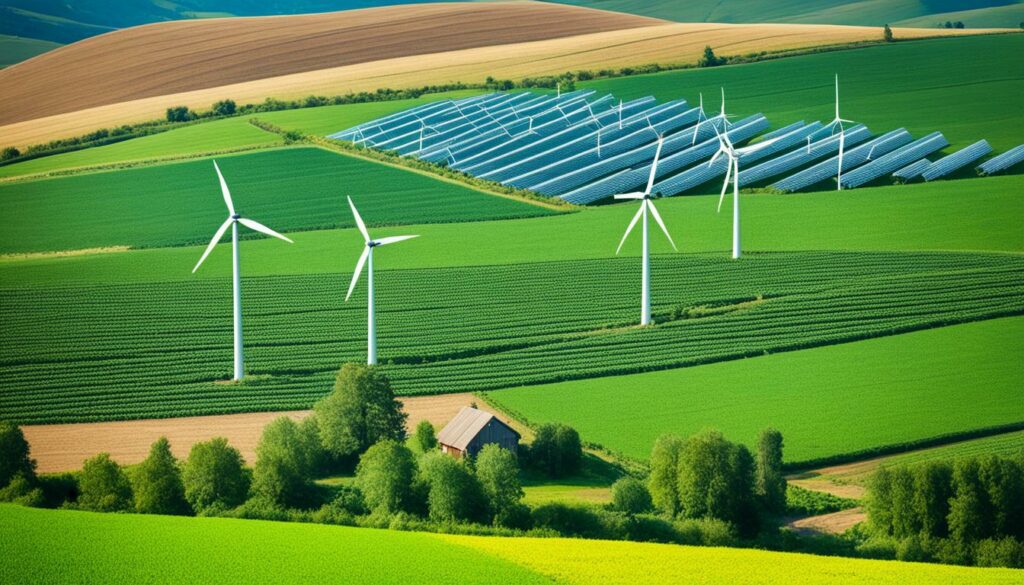
Combining organic farming with green rules brought many good things. It proves that doing both makes farming better for the planet. Some great *successful organic integration case studies* come from the United States and many places worldwide.
In the United States, mixing organic rules with green policies is working well. The Organic Farming Research Foundation (OFRF) showed this through studies. For example, California’s organic farmers stopped using artificial pesticides. This cut down on pollution and helped everyone’s health. Plus, the Biden Administration gave $300 million to the Organic Transition Initiative. This shows the government supports organic farmers, helping them follow both national and environmental standards.
Organic farming is now a $70 billion industry. This shows it’s not just good for the planet, but also for business.
Looking worldwide, lots of *successful organic integration case studies* prove this method works. In Europe, going organic became popular in the 20th century. Back then, people worried about the impact of usual farming on the environment and health.
European countries started offering money and certificates to help organic farming. This led to more people knowing about and wanting organic products, even if they cost more. The European Union (EU) has rules that make sure organic food is made in ways that protect the soil, keep many plant and animal species alive, and reduce the bad effects on the climate.
The EU plans that by 2030, 30% of all farmland in Europe will be used for organic farming. This goal shows a big step towards farming that helps the planet and the people living on it.
Here are detailed comparisons of successful organic farming practices in the US and Europe:
| Aspect | United States | Europe |
|---|---|---|
| Government Support | $300 million funding for Organic Transition Initiative | Subsidies and certification programs |
| Market Size | $70 billion | Substantial and growing |
| Environmental Regulations | Organic Foods Production Act, NOP compliance | EU regulations ensuring organic standards compliance |
| Consumer Awareness | Increasing with market expansion | High, with organic products gaining premium prices |
| Biodiversity Support | Adoption of non-synthetic pest controls | Practices promoting crop rotation and polyculture |
By learning from these *global organic farming practices* and case studies, it’s clear that mixing organic rules with environmental standards creates a good way to farm. It gives farmers more money, takes care of the environment, and gives people the products they want in a way that’s good for the planet.
Organic food is grown in a way that helps our environment. By using fewer pesticides, it keeps our ecosystem healthier. This leads to food that’s safer for us to eat.
Organic farmers use fewer synthetic pesticides. This helps in many ways, like keeping water cleaner and not harming bees and other helpful insects. It means the soil and areas around the farms don’t get filled with bad chemicals.
Organic farming also helps bring more kinds of living things to an area, known as biodiversity. By not using artificial materials and focusing on better soil, organic farms are better homes for different plants and animals. This makes for a richer variety of life and healthier surroundings all round.
Some countries are pushing to have more organic farming land to boost this. Countries like Finland, Austria, and Germany want 20% to be organic. Places like Sikkim in India and Bhutan are already at 100%, seeing more types of life and a better balance in nature.
As we need more food by 2050, it’s crucial to make the way we grow it sustainable. Promoting more organic farming can meet our future food needs without hurting the planet as much as usual farming does.
When we look at the environmental impact assessment, we see big differences between conventional and organic farming. Conventional farming uses man-made products like fertilisers, pesticides, and growth regulators. This often harms the soil and reduces plant and animal variety in the area.
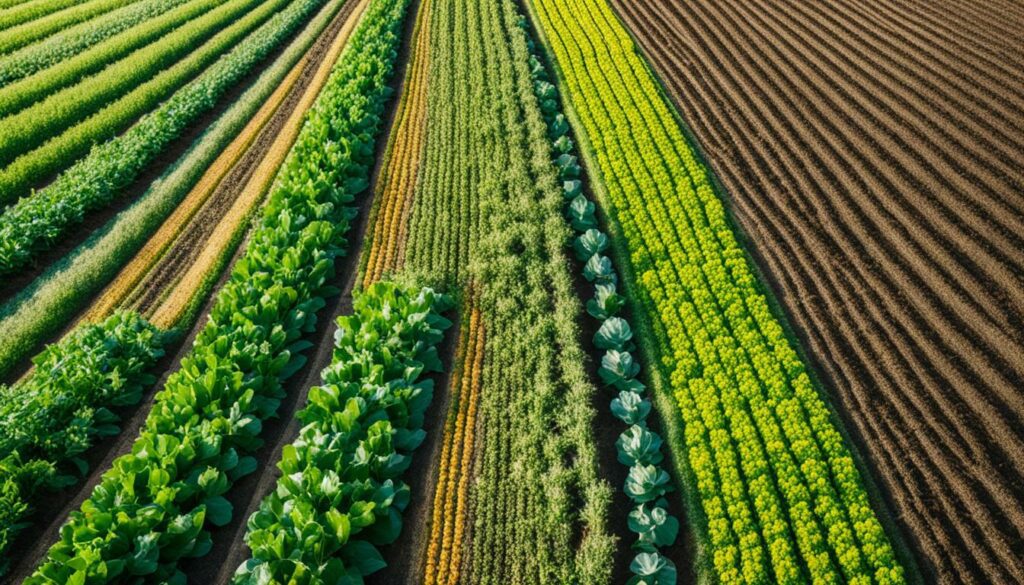
On the flip side, organic farming relies on natural methods and materials. Organic animals eat food that is certified as organic. They only get antibiotics if it’s really needed. These strict rules are all about being kind to the environment.
Clark and Tilman’s detailed research looked at 742 farms growing 90 different types of food. They found out that organic farms use less energy. But, they usually need more space to produce the same amount of food as conventional farms. There is a clear trade-off here.
They also discovered that organic farming can cause more acid rain and too many nutrients in the water. This is because the way they use nutrients is different. However, the effect on the climate change varies. For example, organic peas from Sweden produced half the more greenhouse gases than normal peas.
Though organic farming only made up 3 percent of food sales in the US by 2012, other places are doing more. Countries like Bhutan and Sikkim are moving quickly towards all-organic agriculture. This shows a growing global trend towards eco-friendly farming.
The ongoing discussion about conventional vs organic farming is about finding the right balance. This balance needs to consider both food needs and the health of our planet. Knowing the pros and cons of each helps us make choices that support sustainable farming.
The future of organic agriculture will be shaped by key trends and new rules. These aim to make farming more sustainable and fight the effects of climate change. In the United States, the amount of land certified as organic has grown to 4.89 million acres in 2021. This shows a big push towards organic farming.
Over the years, normal grocery stores have sold more organic food than health food shops. In 2021, they sold 55.6 percent of all organic products. Also, the budget for researching organic farming has grown from $3 million in 2002 to $50 million in 2023. This money is crucial for finding new ways to farm organically.
In 2021, organic sales made up about 3 percent of all farming income in the U.S. But, the land used for organic farming is less than 1 percent of total farmland. Still, people’s love for organic fruits and vegetables has made the sale of these products reach over $22 billion in 2022.
There will be more rules to protect the environment in the organic farming world. It’s important for future trends in farming to work well with these rules. This will keep the earth healthy.
The amount of land used for organic farming has been going up since 2000. Even though some years saw a decrease. The sale of organic products has grown a lot in places like the Delta. Here, organic sales went up by a massive 3,582 percent from 2012 to 2021.
How people buy food is also changing. Buying straight from the farm got very popular, hitting 12.6 percent in 2021. And buying food online grew from 2.1 percent in 2012 to 6.5 percent in 2021. Different places have different ways of selling. For example, 20 percent of what California makes, it sells directly. But in Indiana, it’s just 1 percent.
| Year | Organic Sales | Organic Acreage (millions) | Direct-to-Consumer Sales | Internet Sales |
|---|---|---|---|---|
| 2000 | $19 billion | 1.4 | 5% | 0.2% |
| 2012 | $28 billion | 4.1 | 7% | 2.1% |
| 2021 | $56 billion | 4.89 | 12.6% | 6.5% |
Linking organic farming standards with environmental laws is key for a sustainable farming future. It takes a mix of methods, getting everyone involved. This setup aims to mix high productivity with caring for nature.
Many groups working together is important for making this work. Farmers, buyers, people who make the rules, and teachers need to team up. A lot of people around the world are ready to make changes for the planet. Together, we can make rules friendlier to nature, teach about green ways, and help farmers go organic.
By using new ideas in growing food, we can deal with challenges and keep up with the rules. Things like planting trees among crops and changing what we grow in each field can help a lot. These ways use nutrients and water better, making farming last longer.
Farming is a big part of what causes climate change, making a quarter of the world’s greenhouse gases. But, we can use new tech and old tricks to farm better for the planet. This helps farmers do their job and meets goals set by the Paris Agreement for a healthier world.
Organic farming sets rules for growing and processing food. It bans the use of synthetic chemicals. Instead, it opts for natural sources for pest control. These rules also demand the use of non-synthetic materials.
They don’t allow some practices like using sewage sludge or genetic engineering.
Rules are vital to keep nature balanced and protect different species. They encourage farming that doesn’t harm the planet, ensuring safe soil and water. These regulations also help keep wildlife homes safe.
In the late 1940s, it started with small gardens. By the 1990s, the industry grew a lot. Laws then unified how organic food is produced across the United States.
The NOP is part of the USDA. It ensures organically grown food meets the same standards everywhere. Their work builds trust in organic products.
Eco-friendly farming focuses on keeping nature healthy. It includes things like rotating crops and using waste for fertility. These methods help farms last for the future.
Bringing standards and regulations together helps farming protect nature. This approach supports goals for keeping our planet healthy everywhere.
Organic farms are good for the planet. They don’t use harmful chemicals, so they help the climate. They also make the soil better at storing carbon.
Mixing organic rules with wider farming faces hurdles. There’s a need to meet rising demand without harming nature. Finding ways to farm large areas organically is a big challenge.
Certifications like USDA Organic show foods are grown right. They ensure no GMOs and animals are fed well. This helps shoppers trust what they buy is truly organic.
Green policies encourage organic and eco-friendly farming. They help farmers switch and support research. Plus, they teach people to choose sustainable food.
Yes, many places show how organic and eco-rules can work together. They prove farming can support the environment while thriving. This leads to benefits for everyone, like stronger communities and better markets.
Organic foods help protect water and reduce harm to the environment. They also support a wider mix of plant and animal life. This helps keep our ecosystems healthy.
Traditional farming can hurt the Earth with chemicals and intense farming. Organic ways are gentler, keeping the environment and its creatures safe. There is debate on which method is better for our food and nature.
The future sees closer links between organic farming and environmental laws. New tech and awareness will play big roles. These will help organic farming fit better with how we protect our planet.
Working together is key, with farmers, shoppers, law makers, and teachers. Mixing new tech with old ways can make farming productive and safe for the Earth. This ensures organic farming is around for the long term.